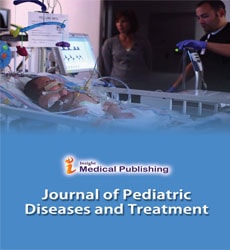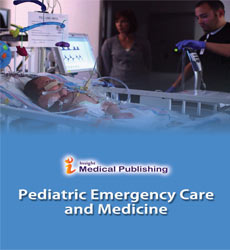Correlative Pain Treatment in Hospitalized Patients with Sickle Cell Sickness
Magipedi Lokesh
DOI10.36648/ippecm.21.6.25
Magipedi Lokesh*
Department of Pharmacy, Jawaharlal Nehru Technological University, Hyderabad, Telangana, India
- *Corresponding Author:
- Magipedi Lokesh
Department of Pharmacy
Jawaharlal Nehru Technological University
Hyderabad, Telangana, India
E-mail: lokesh.m369@gmail.com
Received Date: September 09, 2021; Accepted Date: September 23, 2021; Published Date: September 30, 2021
Citation: Lokesh M (2021) Correlative Pain Treatment in Hospitalized Patients with Sickle Cell Sickness. Pediatr Emerg Care Med Open Access. Vol.6 No.5:25.
Brief Note
Due of deficient administration of vaso-occlusive torment scenes (VOE) in patients with sickle cell sickness (SCD), we looked to decide whether vivid VR would be doable for inpatients. Optionally, we speculated that a solitary VR meeting would further develop the VOE torment insight. Successive patients with SCD eight years and more established conceded for VOE were offered one 15-minute VR meeting, using an unwinding submerged world explicitly made for pediatric patients and to limit potential test system incidental effects. Wellbeing and worthiness were assessed with a short review prior and then afterward the meeting. Torment was assessed using the approved young adult pediatric aggravation apparatus (APPT). Review information and torment scores were investigated utilizing Wilcoxon marked position test as the information were non-normally dispersed. VR treatment was plausible in a companion of patients with SCD conceded for VOE. Notwithstanding standard treatments, VR might assist with diminishing the aggravation experience with SCD VOE. Further review is needed to decide the effect of VR treatment on narcotic use and length of stay in medical clinic.
Patients with sickle cell illness (SCD) and malignant growth frequently have convoluted courses while hospitalized and regularly manage agony, nervousness and melancholy. Advances in the area of innovation give expected roads to imaginative and further developed consideration models for our patients. Computer generated reality (VR) has been as of late used to further develop uneasiness and agony in an assortment of patient populaces including kids going through elective medical procedure and kids encountering intravenous cannulation in the Emergency Department. Patients with SCD and malignant growth, the two grown-ups and youngsters, are a gathering of patients that can profit from VR as a feature of their consideration. In the course of recent years, our group has effectively carried out a few self-created versatile ("applications") for our patients, as well as incorporating target information (pulse, movement, stress) from wearable action trackers.
The specialists currently propose executing a plausibility study followed by a pilot study and randomized-controlled preliminary of the utilization of VR in patients with SCD and malignancy. The specialists intend to evaluate agony and tension before the meeting just as following the meeting in hospitalized patients and outpatients with SCD and disease. The meetings will incorporate a ten-minute unwinding reaction initial account portion (profound breathing and care) trailed by a ten-minute described and vivid VR. Pulse will be followed utilizing an Apple iWatch for 30 minutes before the meeting, during the meeting, and following the meeting. We expect VR won't just be a plausible technique to give non-pharmacologic treatment, yet will likewise essentially decrease agony and nervousness.
The examiners will play out a possibility and pilot study assessing unwinding reaction (portrayal driving through profound breathing, care, and other unwinding methods) trailed by VR in patients with sickle cell sickness (SCD) and caner. The VR headset (NeuTab VR Virtual Reality Headset, Dynamic Virtual Viewer, or comparable gadget) utilized will be viable with an iPhone bought by the PI. The VR meeting will be described by Jon Seskevich, RN. Patients will be furnished with a second iPhone to play the recording while the other iPhone is utilized to show the VR meeting.
The patients will initially be given an assent structure and agreed. They will have the chance to pose inquiries preceding and following assent. They will therefore give an aggravation score and round out a GAD-7 (Generalized Anxiety Disorder) and PHQ-9 (Patient Health Questionnaire) structure. They will be encouraged how to utilize the VR headset. Patients will pay attention to a recording by Jon Seskevich, RN of a ten-minute unwinding reaction. An iPhone will then, at that point be set in the VR headset, the recording began, and the headset set on the patient. The VR scene is accessible through Provata VR application and has been recently picked preceding the beginning of the review. Following this, patients will again give an aggravation score just as complete another GAD-7, PHQ-9, Presence Questionnaire, and Patient's Global Impression of Change (PGIC) structure. Patients will be approached to round out torment score and general wellbeing questions by means of the TRU-Pain application. Patients can then pose inquiries/give further input.

Open Access Journals
- Aquaculture & Veterinary Science
- Chemistry & Chemical Sciences
- Clinical Sciences
- Engineering
- General Science
- Genetics & Molecular Biology
- Health Care & Nursing
- Immunology & Microbiology
- Materials Science
- Mathematics & Physics
- Medical Sciences
- Neurology & Psychiatry
- Oncology & Cancer Science
- Pharmaceutical Sciences
